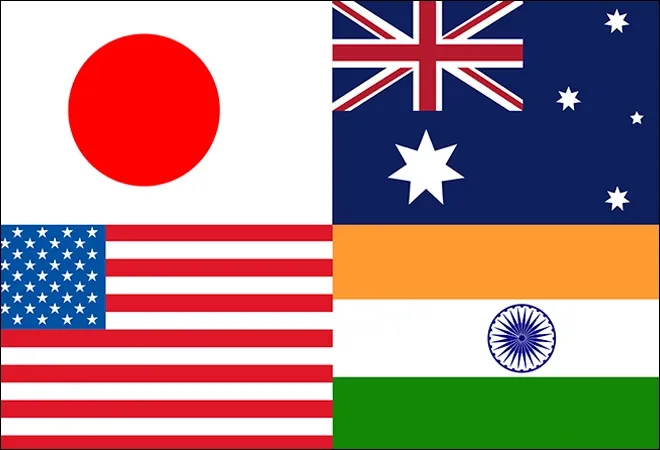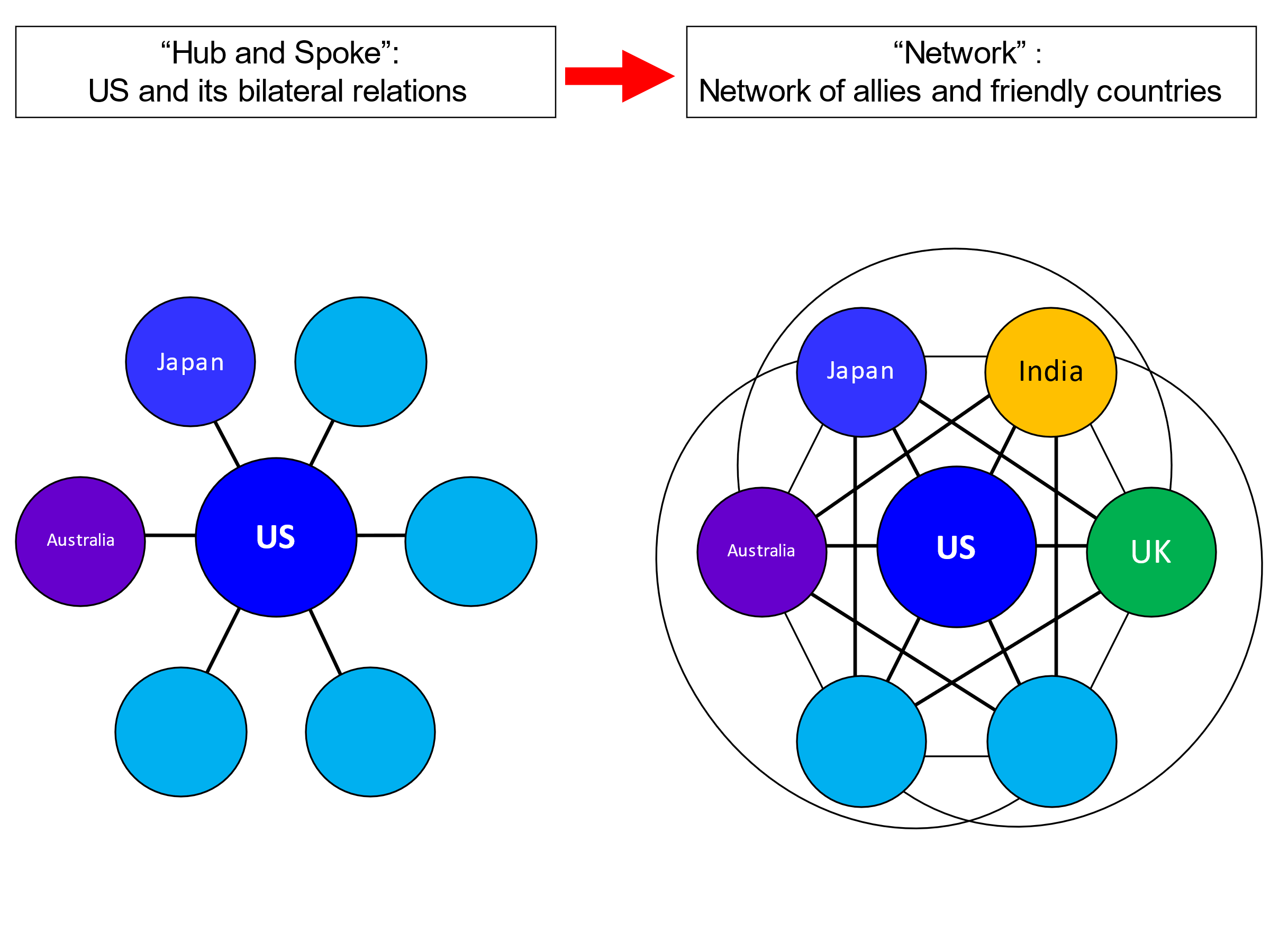
This article is part of the series — Raisina Files 2022.
An important feature of Japan’s current strategic policy is its concept of the Quadrilateral Security Dialogue (QUAD) in the Indo-Pacific. Japan was a pioneer in creating the concept of both the QUAD and the Indo-Pacific area. Prime Minister Shinzo Abe’s speech to the Indian parliament in 2007—entitled “Confluence of Two Seas”—introduced the idea (although he did not use the word “QUAD” specifically).<1>
Why does Japan need the QUAD? Since the 2000s, the security situation around Japan has changed, especially since China has escalated its activities in the entire Indo-Pacific area. As a result, the QUAD has an important role to play in the resolution of this issue. This article will focus on three things: What are the features of China’s territorial expansion? How should the QUAD respond? And finally, what problems should the QUAD be anticipating?
What are the Features of China’s Territorial Expansion?
Japan and India Share the Same Problem
The QUAD countries, including Japan and India, are experiencing the same problem: A steady increase in Chinese presence and activity near their borders. For example, in the sea around the Senkaku Islands of Japan, China has employed its coast guards and increased its activities. In 2011, the number of Chinese vessels identified within the contiguous zone in the waters surrounding the Senkaku Islands in Japan was only 12. But the number increased to 428 in 2012; 819 in 2013; 729 in 2014; 707 in 2015; 752 in 2016; 696 in 2017; and 615 in 2018. By 2019, the number had reached 1097.<2>
In the case of the Indo-China border, Beijing has also stepped up its activities. In 2011, India recorded 213 incursions in the Indo-China border area, but in the following years, the numbers were larger: 426 in 2012; 411 in 2013; 460 in 2014; 428 in 2015; 296 in 2016; 473 in 2017; 404 in 2018; and 663 in 2019. Based on the number of Chinese incursions in the Indo-China border area and Chinese activities in the sea around the Senkaku Islands, it becomes apparent that China has increased its assertiveness in 2012 and 2019 in both regions (see Figure 1).
Figure 1: Comparison of China’s activities in two regions

Three Important Similarities of China’s Territorial Expansion
China’s territorial expansion has three features. The first feature of note is China’s repeated disregard for current international law when laying claim to new territory. In the East China Sea, China did not claim the Senkaku Islands before 1971, but its attitude has since changed. The Senkaku Islands are in a strategic location to pressure Taiwan and have potential oil reserves. In the case of the Indo-China border, the Tibetan exile government has stated that these areas belong to India.<3> China has ignored current international law and expanded its territorial claim.
The second feature of China’s territorial expansion is timing. Beijing has exploited the situation whenever it finds a power vacuum. For example, China occupied half of the Paracel Islands just after France withdrew in the 1950s, and occupied the other half in 1974. This was one year after the United States withdrew from South Vietnam. In the 1980s, China expanded its activities in the Spratly Islands and occupied six features there in 1988, just after the Soviet Union decreased its military presence in Vietnam. And in 1995, China occupied Mischief Reef, three years after the US troops withdrew from the Philippines.<4> These activities indicate that China tends to expand its territorial reach when military balances change and power vacuums are detected. Over the past decade, the military balance has been changing. According to the Stockholm International Peace Research Institute Military Expenditure Database, from 2011-20, China increased its military expenditure by 76 percent. During the same period, India increased its military expenditure by 34 percent, Australia by 33 percent, and Japan by only 2.4 percent. The United States decreased its expenditure by 10 percent.<5> China has tried to expand its territorial claims not only in the South China Sea, but also in the East China Sea, Taiwan, the Indo-China border, and the Indian Ocean because it sees a power vacuum in these areas.
A third feature of China’s territorial expansion is non-military control. China has used foreign infrastructure projects—known as the Belt and Road Initiative—to expand its sphere of influence. Countries with significant Chinese investment and debt are hesitant to criticise China, even when it flouts international rules. China has also been using “vaccine diplomacy” for COVID-19 to foster goodwill among recipient countries. Thus, for China, non-military methods like infrastructure projects, supply chain dependence, and vaccines serve to expand its influence and power. Even on developed countries like Japan and Australia, China uses this method of economic control. For example, when Australia insisted on an international investigation to identify the origin of COVID-19, China delayed processing imports like wine and lobster from Australia.<6> Dependence on the Chinese market is a powerful weapon for Beijing to expand its influence, and ultimately expand its territories.
How should the QUAD Respond?
Respecting Rules-Based Order
First, the QUAD must continue to respect and insist upon a rules-based order grounded in current international law. The joint statements of both QUAD summits in March and September 2021 mention that a free, open, rules-based order will “meet the challenges to the rules-based maritime order, including in the East and South China Seas.”<7> These words carry great significance because China has tried to change the status quo by force and continually challenges international norms.
Maintaining Military Balance
Second, the QUAD countries need to fill perceived power vacuums by maintaining a military balance. To do this, they need to increase their defence budgets, which is not an easy task. Therefore, reorganising the security system itself is important. For a long time, a “hub and spoke” system has maintained order in the Indo-Pacific. In this system, the hub is the US and the many spokes are US allies such as Japan, Australia, Taiwan, the Philippines, Thailand, and South Korea in the Indo-Pacific. A feature of the current system is that it heavily depends on the US. For example, even though Japan and Australia are both US allies, there is no Japan-Australia alliance. However, China’s recent provocations indicate that the current system has not worked to dissuade its expansion. As mentioned above, between 2011-20, China increased its military expenditure 76 percent, and the US decreased its expenditure by 10 percent. Even if the US military expenditure were three times bigger than China’s, the current “hub and spoke” system would still not be enough.
Figure 2: “Hub and spoke” and network-based security systems

As a result, a new network-based security system is emerging. American allies and partners cooperate with each other and share security burdens with the US and among themselves. Many bilateral, trilateral, quadrilateral, or other multilateral cooperation arrangements—such as US-Japan-India, Japan-India-Australia, Australia-UK-US, India-Australia-Indonesia, India-Australia-France, US-India-Israel-UAE—are creating a network of security cooperation. In this case, the QUAD is one example of countries cooperating with each other and sharing the regional security burden.
If the QUAD countries coordinate well, they can force China to defend multiple fronts at once and, thereby, dissuade China’s territorial expansion. In such a scenario, China would need to simultaneously make defence expenditures against the US and Japan on the Pacific side, as well as against India on the India-China border side. This sort of cooperation would provide a way to maintain a military balance even if China’s military expenditure were rising at a rapid pace.
In this case, offensive capability is the key. For a long time, no countries except the US, Japan, Australia, and India possessed enough capability to attack China. However, if the US, Japan, and India all possess long-range strike capabilities, their combined capability forces China to defend multiple fronts. Even if China decides to expand its territories in the Indo-China border, it will still need to expend a certain amount of its budget and military force to defend itself against a potential attack from the US and Japan. Currently, Japan, India, and Australia are all planning to possess 1000-2000 km long-range strike capabilities, such as cruise missiles, and F-35 jets with glide bombs and cruise missiles.<8> Indeed, Taiwan, Vietnam, the Philippines, and South Korea are also increasing their strike arsenal with surface-to-surface missiles. In the case of the Philippines, Manila decided to import BrahMos cruise missiles from India.<9> These moves could be key in dissuading China from its current path of expansion.
In September 2021, Australia, the UK, and the US announced that they had formed AUKUS, a trilateral security arrangement in the Indo-Pacific. In this alliance, the US and the UK will support Australia to acquire and maintain eight nuclear submarines. If Australia possess nuclear submarines with long-range strike capabilities, Australian naval forces can operate in a far wider area in the Indo-Pacific, and potentially counter China’s threat in that area.
Integrate military and non-military policy as one overall strategy
Third, the QUAD needs to integrate non-military efforts into its overall strategy. These will be a very important part of any counter-China strategy, because China’s threat is bound up with the strength of its budget. It can change the status quo by force when its military power is stronger than others, and so maintaining a military balance is important. However, because of its strong economy and ample budget, China’s military modernisation has outpaced that of other countries. That is why non-military efforts are needed to reduce China’s economic advantage.
In the case of foreign infrastructure projects, the situation is the same. Because of its favourable economic situation, China can invest heavily in these projects and create huge debts and obligations for recipient countries. These countries then tend to follow China’s lead in international organisations such as the World Trade Organization. Therefore, reducing China’s ample budget and its influence is an important priority.
Other issues are similar: Because China is rich, it can deliver COVID-19 vaccines to expand its influence; it can dominate rare earth mines in the world and affect supply chains for critical technology; and it has been able to dominate solar panel production and expand its presence in that sector as strict new rules regarding climate change are imposed.
Therefore, the QUAD countries need to integrate their economic efforts and reduce their reliance on China. Decoupling and risk-diversifying of supply chains and markets are necessary. Japan, for its part, has already begun to do so—it has relocated its factories from China to Southeast Asia and South Asia and the number of Japanese citizens living in China has decreased from 150,399 in 2012 to 111,769 in 2020. At the same time, the number of Japanese living in the US has increased from 410,973 in 2012 to 426,354 in 2020.<10> In addition, Japan earmarked US$2.2 billion of its 2020 economic stimulus package to help local manufacturers shift production out of China.<11>
What Problems should the QUAD be Anticipating?
Russia is Foremost
Currently, the most important obstacle the QUAD must overcome is relations with Russia. When Russia invaded Ukraine, Japan’s very clear stance was that it would support Ukraine for three reasons. First, Russia could not credibly justify its military operation to the United Nations (UN). This means that it is using unilateral action to change the status quo by force. If the international community, including Japan, allows Russia to win the war, China will follow Russia’s example by using the same type of invasion against Taiwan, India, and possibly others. This is not acceptable for Japan. Second, if Russia wins the war against Ukraine, the US will need to prioritise Russian deterrence in Europe. The US could not withdraw its military forces from Europe and redeploy them to the Indo-Pacific to deter China. Japan is aware that it would face a serious situation if it had to deter Russia and China at the same time. Third, Japan shares a border with Russia and has fought a war with Russia in the past. In recent years, Russia has repeatedly provoked Japan. For example, in 2020, Russian military planes tried to enter Japan’s territorial airspace 258 times, setting off repeated “scrambles” of Japan’s Air Self Defense Force fighter jets. In 2021, five Chinese warships and five Russian warships jointly circled Japan.<12> These incursions are evidence that Russia is a threat to Japan. The US and Australia share the same interests with Japan vis-a-vis Russia.
However, for India, Russia is important. India's military equipment depends on supplies of repair parts and ammunition from Russia. Despite India’s weapons being high-end, sensitive machines, its soldiers need to use them in tough conditions, and having access to repair parts is vital. Additionally, Russia backs India in its fight against Pakistan’s support of terrorist camps within its borders. There is a possibility that the international community will ask India to stop its military operation in Pakistan, but Russia will vote in the UN Security Council in favour of India. In addition, because India depended on the Soviet Union during the Cold War, their human-to-human connection is still deep and influential. Therefore, the stance of Japan-US-Australia and the stance of India are completely different when it comes to Russia—posing a threat to the QUAD cohesion.
Will India Need Russia?
Will this situation continue in the future? Indeed, the situation is already changing. Figure 3 shows the share of arms suppliers for India. Arms imported from the US, the UK, France, and Israel are blue and arms imported from the USSR or Russia are shown in red. Before 1962, most arms suppliers were blue countries. But since 1962, the USSR or Russia have been the main arms suppliers for India. However, India has recently imported more weapons from the US, the UK, France, and Israel than Russia. Until now, Russia has been the main arms supplier for India to maintain its current equipment, but that is changing.
Figure 3: Share of arms suppliers for India

*Stockholm International Peace Research Institute (SIPRI) Arms Transfer Database (https://www.sipri.org/databases/armstransfers )
In addition, the US has started to side with India in its crackdown against state-sponsored terrorism in Pakistan. When India attacked terrorist camps in Pakistan in 2016 and 2019, joint statements of India-US, India-Japan, and the QUAD offered support for India’s effort to deal with terrorism.
India’s alliance with Russia has changed. Russia is supporting China, which is a serious security threat for India. Russia is exporting weapons to India’s rival, Pakistan as well. For example, the engine of the China-Pakistan joint development fighter jet JF-17 (and J-10 also) is a Russian product.<13> Russia also sold Mi-35 attack helicopters to Pakistan.<14> It is likely that in the near future, Russia will cease to be an impediment to the QUAD cooperation.
China’s aggressive territorial expansion gave rise to the QUAD in the Indo-Pacific and because China has escalated its activities, the QUAD countries must show their strength. The more China escalates the situation, the more the defence capabilities of the QUAD will be institutionalised in the Indo-Pacific.
<1> Shinzo Abe, “Confluence of the Two Seas” (speech, New Delhi, August 22, 2007).
<2> “Trends in Chinese Government and Other Vessels in the Waters Surrounding the Senkaku Islands, and Japan's Response,” Ministry of Foreign Affairs of Japan.
<3> “‘Ladakh belongs to India’: Tibet sides with India, exposes China’s expansionist tactics,” Central Tibetan Administration.
<4> Japan Ministry of Defense, China’s Activities in the South China Sea(China’s development activities on the features and trends in related countries), Tokyo, 2021.
<5> Diego Lopes da Silva, Nan Tian, Alexandra Marksteiner, “Trends in World Military Expenditure, 2020,” Stockholm International Peace Research Institute.
<6> Bloomberg, “China to halt key Australian imports in sweeping retaliation,” Hindustan Times, November 3, 2020.
<7> Ministry of Foreign Affairs of Japan, Quad Leaders’ Joint Statement: The Spirit of the Quad, March 2021; Ministry of Foreign Affairs of Japan, Joint Statement from Quad Leaders, September 24, 2021.
<8> Satoru Nagao, “Strike capabilities of Japan, India, Australia key for US-led counter-China strategy,” Sunday Guardian Live, February 27, 2021.
<9> Dinakar Peri, “Philippines inks deal worth $375 million for BrahMos missiles,” The Hindu, January 28, 2022.
<10> “Statistics on the number of Japanese residents abroad,” Ministry of Foreign Affairs of Japan.
<11> Reynolds Isabel and Urabe Emi, “Japan to Fund Firms to Shift Production Out of China,” Bloomberg, April 8, 2020.
<12> Mari Yamaguchi, “Tokyo concerned over China-Russia naval drills near Japan,” AP, October 25, 2021.
<13> “Russia confirms progress on new jet engine. Is it for Pak JF-17 fighter?” The Week, July 9, 2020.
<14> Franz-Stefan Gady, “Pakistan Begins Receiving Advanced Attack Helicopters From Russia,” The Diplomat, April 12, 2018.
The views expressed above belong to the author(s). ORF research and analyses now available on Telegram! Click here to access our curated content — blogs, longforms and interviews.







 PREV
PREV


